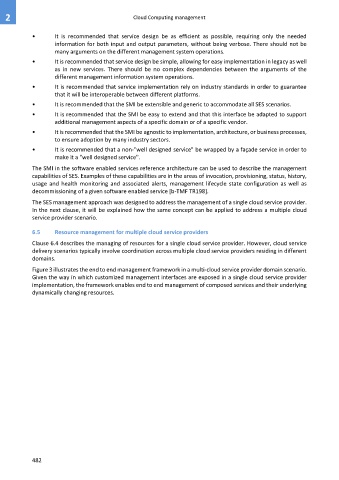Page 490 - Cloud computing: From paradigm to operation
P. 490
2 Cloud Computing management
• It is recommended that service design be as efficient as possible, requiring only the needed
information for both input and output parameters, without being verbose. There should not be
many arguments on the different management system operations.
• It is recommended that service design be simple, allowing for easy implementation in legacy as well
as in new services. There should be no complex dependencies between the arguments of the
different management information system operations.
• It is recommended that service implementation rely on industry standards in order to guarantee
that it will be interoperable between different platforms.
• It is recommended that the SMI be extensible and generic to accommodate all SES scenarios.
• It is recommended that the SMI be easy to extend and that this interface be adapted to support
additional management aspects of a specific domain or of a specific vendor.
• It is recommended that the SMI be agnostic to implementation, architecture, or business processes,
to ensure adoption by many industry sectors.
• It is recommended that a non-"well designed service" be wrapped by a façade service in order to
make it a "well designed service".
The SMI in the software enabled services reference architecture can be used to describe the management
capabilities of SES. Examples of these capabilities are in the areas of invocation, provisioning, status, history,
usage and health monitoring and associated alerts, management lifecycle state configuration as well as
decommissioning of a given software enabled service [b-TMF TR198].
The SES management approach was designed to address the management of a single cloud service provider.
In the next clause, it will be explained how the same concept can be applied to address a multiple cloud
service provider scenario.
6.5 Resource management for multiple cloud service providers
Clause 6.4 describes the managing of resources for a single cloud service provider. However, cloud service
delivery scenarios typically involve coordination across multiple cloud service providers residing in different
domains.
Figure 3 illustrates the end to end management framework in a multi-cloud service provider domain scenario.
Given the way in which customized management interfaces are exposed in a single cloud service provider
implementation, the framework enables end to end management of composed services and their underlying
dynamically changing resources.
482

